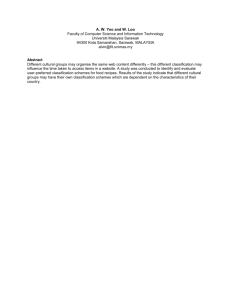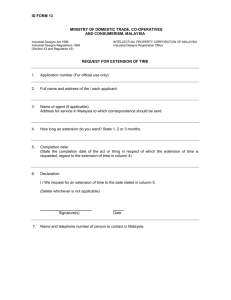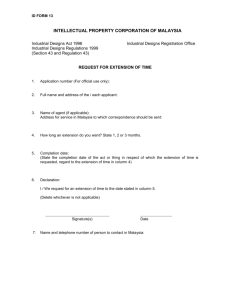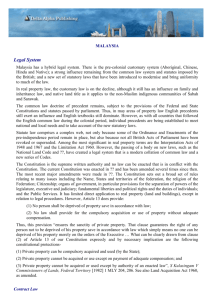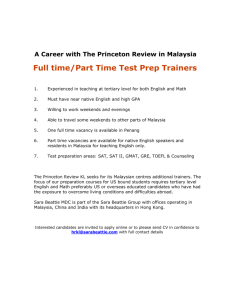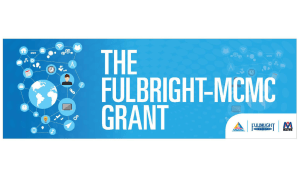Member Country Report of MALAYSIA
advertisement
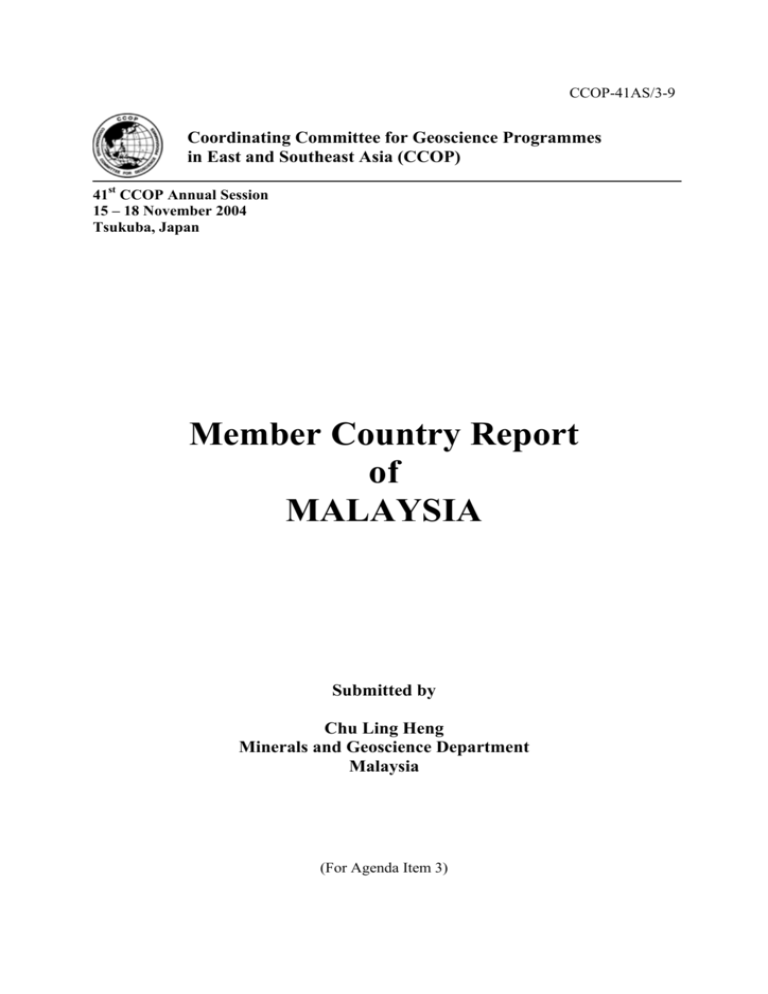
CCOP-41AS/3-9 Coordinating Committee for Geoscience Programmes in East and Southeast Asia (CCOP) 41st CCOP Annual Session 15 – 18 November 2004 Tsukuba, Japan Member Country Report of MALAYSIA Submitted by Chu Ling Heng Minerals and Geoscience Department Malaysia (For Agenda Item 3) COORDINATING COMMITTEE FOR GEOSCIENCE PROGRAMMES IN EAST AND SOUTHEAST ASIA (CCOP) 24th Floor, Suite 244-245, Thai CC Tower, 889 Sathorn Tai Road, Sathorn, Bangkok 10120, Thailand. Tel: (66) 02 672 3080, Fax: (66) 02 672 3082, E-mail: ccopts@ccop.or.th, Website: www.ccop.or.th ANNUAL MEMBER COUNTRY REPORT Country: MALAYSIA Period: 1 July 2003 – 30 June 2004 GEO-RESOURCES SECTOR 1. MINERAL PROGRAMME 1.1. Summary Reconnaissance and follow-up geochemical surveys for gold and the evaluation of industrial mineral resources, namely clay, silica sand, dimension stone and feldspar, were undertaken during the period. At the same time, research programmes into clay, silica, rock, advanced material, and rehabilitation technologies were continued. Meanwhile, coal exploration was continued in Sarawak and Sabah. 1.2. Annual Review of Technical Programmes / Activities Regional geochemical surveys resulted in the collection of 3,057 geochemical samples over a total area of 3,666 km2. In Sarawak, 1,117 samples were collected in the Lemanak, Layar and Paku areas; total coverage was 1,496 km2. A total of 883 geochemical samples were collected in the Sandakan area, Sabah, over an area of 1,400 km2. In Peninsular Malaysia, reconnaissance geochemical sampling was concentrated in the states of Perak (950 samples over 670km2 in the Siput, Tapah, Gunung Batu Puteh and Tanjung Malim areas), and Kedah (107 samples over 100 km2 in the Kulim - Bandar Bahru area). Follow-up surveys for gold, meanwhile, were carried out in Johor where three potential areas totalling 3.3 km2 were outlined. In Pahang, gold flakes were detected in many localities in the heavy stream concentrates west of the Jeram area, and the results of a pitting programme in the Lipis area indicated the existence of gold colours in some of the pits. The Tapah area in Trengganu shows some promise as a potential gold target following an evaluation of the follow-up results, and in Kelantan, the Felda Chiku-Serasa Forest Reserve area similarly appears promising for further gold exploration. Several potential granite and limestone resources in Negri Sembilan, Kedah, Kelantan and Sabah have been identified for dimension stone development, while in Kelantan and Pahang, the feldspar occurrence was assessed through reconnaissance drilling. Indications are that the feldspar meets industrial specifications. Research on local silica sand resources indicate that they have the potential to be used for the manufacture of crystal glass and to support glass ceramics development. Research into the development of whiteware ceramic body recipes using local clay resources have 41st CCOP Member Country Report: MALAYSIA 1 produced commendable results. Ponds in ex-mining land have been shown to successfully support the cultivation of various flora, and this observation has attracted the attention of the agricultural sector. Coal exploration was continued in Marapok and Ulu Tutuh, Sarawak totalling 180 km . In the former area, coal seams with a maximum thickness of 0.6m were recorded, while at Ulu Tutuh, seams ranging from 0.5 to 1.5m thick were noted. About 100 km2 of the eastern segment of the Middle Pinangah area in Sabah was surveyed for its coal potential. Unfortunately, unlike the western portion, no coal seams were found. 2 1.3. Porposed Future Activities and Assistance Required from CCOP in Support of Future Activities: (i) (ii) Continue with data collection through geochemical and offshore surveys. Evaluation of industrial mineral resources and R&D work on such resources to be continued. (iii) Assistance requested for will be in:(a) integration of geochemical, geophysical, geological data. (b) capability building in R&D with specific reference to industrial minerals. 2. ENERGY PROGRAMME 2.1. Summary During the review period, various oil companies carried out data reviews on the prospectivity of Malaysian exploration acreage. PETRONAS secured five (5) new Production Sharing Contracts (PSCs) namely: (i) PETRONAS Carigali Sdn. Bhd. and Sarawak Shell Berhad for the 2003 Baram Delta PSC, (ii) PETRONAS Carigali Sdn. Bhd. and Newfield Peninsula Malaysia Inc. for five (5) Peninsular Malaysia Small Fields Development PSC, (iii)Talisman Malaysia Limited and PETRONAS Carigali Sdn. Bhd. for PM314 PSC, (iv) PETRONAS Carigali Sdn. Bhd. and Newfield Peninsula Malaysia Inc. for PM318 PSC, and (v) Newfield Peninsula Malaysia Inc. and PETRONAS Carigali Sdn. Bhd. for Deepwater Block 2C PSC. Extensive exploration activities were carried out by the Production Sharing Contractors. A total of 118,275.7 line km of new seismic data were acquired comprising 11,247 line km of 2D seismic data and 107,028.7 line km of 3D seismic data. Thirty five (35) exploration wells (29 wildcats and 6 appraisals) were drilled resulting in three (3) oil discoveries and three (3) gas discoveries. A total of one hundred-thirty-nine (139) development wells were also drilled during the period. Crude oil and gas production averaged 622,000 bpd and 6,000 MMscf/d respectively. 2 41st CCOP Member Country Report: MALAYSIA 2.2. Annual Review of Technical Programmes / Activities 2.2.1. New Acreage During this review period, five (5) new PSCs (for Baram Delta, Small Fields, Block PM 314, Block PM 318 and Deepwater Sarawak Block 2C) were signed. The new exploration ventures concluded during this period resulted in an increase of about 15,582 sq. km of Production Sharing Contract area, giving an overall total PCS area of 233,554 sq. km for the country. 2.2.2. New Production Sharing Contracts (PSC) Signed A total of five (5) PSCs were signed during the review period. Details of the PSCs signed are tabled below: No 1 2 3 4 5 BLOCK NAME 2003 Baram Delta PSC Peninsular Malaysia five (5) Small Fields Block PM 314 Block PM 318 Deepwater Block 2C, Sarawak DATE PSC SIGNED 18.09.2003 01.03.2004 31.03.2004 25.05.2004 25.05.2004 OPERATOR PCSB PCSB Talisman Malaysia Ltd. PCSB Newfield Sarawak (Malaysia) inc. 2.2.3. Geophysical Surveys The total seismic data acquired was 118,275.7 line km, of which 11,247 line km are 2D seismic data and 107,028.7 line km are 3D seismic data. The details are as follows: REGION Peninsular Malaysia Sabah Sarawak Total 2D SEISMIC 7,151 4,096 11,247 3D SEISMIC 4,648.9 61,360 41,019.8 107,028.7 2.2.4. Exploration and Development Drilling A total of thirty five (35) exploration wells (29 wildcats and 6 appraisals) were drilled with aggregate depth of 86,824.9 mRKB during this period. In addition, a total of 139 development wells were also drilled. (i) Peninsular Malaysia Eighteen (18) exploration wells were drilled offshore Peninsular Malaysia by Production Sharing Contractors. PETRONAS Carigali Sdn. Bhd. has drilled 3 wells, CS Mutiara 2 wells, Murphy Peninsular Malaysia Oil Company Limited 3 wells, Talisman 41st CCOP Member Country Report: MALAYSIA 3 Malaysia Limited 4 wells and PETRONAS 6 wells. About 3 discoveries were made during this review period in Peninsular Malaysia. A total of ninety-seven (97) development wells were also drilled during the review. (ii) Sarawak Six (6) exploration wells were drilled in offshore Sarawak by Production Sharing Contractors. Murphy Sarawak Oil Company Limited drilled 3 wells, Sarawak Shell Berhad 1 well, Amerada Hess 1 well and PETRONAS 1 well. One discovery was made during this review period in Sarawak. A total of twenty-six (26) development wells were also drilled during the review. (iii) Sabah Eleven (11) exploration wells were drilled in offshore Sabah by Production Sharing Contractors. Murphy Sabah Oil CompanyLimited drilled 8 wells and Sabah Shell Petroleum Company drilled 3 wells. Two discoveries were made during this review period in Sabah. A total of sixteen (16) development wells were also drilled during the review. 2.2.5. Production of Oil and Gas In year 2003, Malaysia’s total crude oil production was 621,900 bpd from fourtyseven (47) oil fields. In Peninsular Malaysia, twenty-four (24) fields are currently under production and they are Guntong, Irong Barat, Palas, Seligi, Semangkok, Tabu, Tapis, Bekok, Tiong, Kepong, Angsi, Tinggi, Pulai, Dulang, West Bunga Kekwa, East Bunga Kekwa, North Bunga Raya, Yong, Malong, Sotong, Anding, Lawang, Langat and Serudon. In Sarawak, fourteen (14) oil fields in production namely Baronia, Bakau, Baram, West Lutong, Betty, Bokor, Siwa, Tukau, Fairley Baram, Bayan, Asam Paya, Temana, D-18 and D-35. Meanwhile in Sabah, there are sixteen (16) producing oil fields namely South Furious, St. Joseph, Barton, Tembungo, Samarang, Kinabalu, Alab, SF30 and Erb West. Daily production of gas (associated and non-associated) was 6,126.7 MMscf/d. The Non-Associated Gas is produced from Angsi, Bekok, Tiong, Jerneh, Lawit, Resak and Duyong Fields of offshore Peninsular Malaysia., E11, F6, F23, M3, M1 and M4 Fields of offshore Sarawak, and Samarang Kecil Field of offshore Sabah with an average production of 4,253 MMscf/d. Associated Gas production in Malaysia averaged 1,873.7 MMscf/d. 2.2.6 Reserves As at 1 January 2004, the total hydrocarbon reserves of Malaysia is as summarized below :- 4 41st CCOP Member Country Report: MALAYSIA (i) Crude Oil (ii) Non-associated gas (iii) Associated gas 3.85 Bstb 72,240 Tscf 14,78 Tscf 3. GROUNDWATER PROGRAMME 3.1. Summary Groundwater investigations, development and monitoring were carried out in Sarawak, Sabah, Johor, Kedah and Negri Sembilan. These surveys were largely carried out by the Minerals and Geoscience Department. Private sector involvement, particularly in tube well development, was concentrated in Sarawak and Sabah. 3.2. Annual Review of Technical Programmes / Activities In Sarawak, hydrogeological invenstigations were carried out in Salidap and Kuala Nyalau. While the groundwater potential in Salidap is not promising, the Kuala Nyalau area is capable of producing 10m3 / hr to 20m3 / hr groundwater to support 400 residents. Under the alternative water supply project financed by the Ministry of Rural Development, the Department assisted in the construction of wells in the remote and coastal areas to supply groundwater to some 3,750 villagers. Four exploration wells drilled in hardrock formations in Kanibongan, Rokom, Datong and Bongkol, Sabah, were not promising in terms of groundwater potential. However, in Ambatuan, the 1.5 to 2m3 / hr groundwater yield is sufficient for the needs of 200 residents. In Johor, three wells drilled in hardrock around Pagoh, Lenga and Jementah can yield 785m / day groundwater to supply 4,300 residents. Two wells developed in hardrock in Petani and Gurun, Kedah, meanwhile, are capable of yielding 9m3 / hr and 68m3 / hr groundwater respectively. Groundwater supply for poultry rearing activities were also successfully developed for Machap, Merlimau and Kuala Pilah in Negri Sembilan. 3 3.3. 3.4. Proposed Future Activities and Assistance Required from CCOP in Support of Future Activities. (i) Continue with the development of groundwater resources in various parts of the country. Work will be concentrated in the management of groundwater resources in small islands offshore Terengganu and Johor, (ii) Modeling work and delineation of wellhead protection areas (WHPA) will be carried out in selected areas. Delineation of WHPA using model is proposed for Tioman Island, Pahang. Others The DCGM Phase IV Project Compilation of Groundwater and Geothermal databases for CCOP region was held in Tsukuba, Japan from 23 – 27 February 2004. The Department has finalized 242 Malaysian well data which were handed over to GSJ to be included in the Project’s final groundwater database. 41st CCOP Member Country Report: MALAYSIA 5 GEO-ENVIRONMENT SECTOR 4. COASTAL ZONE PROGRAMME 4.1. Summary Besides the geophysical and sampling programme carried out in the Kuala Ingan – Bintulu offshore area, Sarawak, a multi-beam echo sounding survey, and a side scan sonar survey were also executed in Langkawi. The framework for the National Integrated Coastal Zone Management (NICZM) policy was drafted. The Department of Irrigation and Drainage initiated the preparation of the Integrated Shoreline Management Plan (ISMP) for the North Pahang coastline. 4.2. Annual Review of Technical Programmes / Activities A geophysical survey using multibeam and towed side scan sonar was carried out on the nearshore areas around the Langkawi Islands. A total of 3,862 line-km were covered, encompassing a total area of 1,100 sq km. The areas covered were in the north, west and south of the main island where most of the beaches are located. The towed side scan sonar was carried out only in the northern part of the survey area. The main purpose was to do a comparative study between the conventional towed sonar image with the processed multibeam sonar image. Under this project, the multibeam survey is being evaluated as a tool for coastal zone mapping in shallow waters. Preliminary analysis of the multibeam result showed the detailed morphology of the sea bed and sea bottom features, like the sand migration patterns, sediment characteristics and sand dredged areas. A geophysical and sampling survey was carried out in Sarawak, between Kuala Igan and Bintulu, in 2003. A total of 1,386 line-km of geophysical data, and 112 grab and core samples from the sea bottom were gathered over an area covering 10,050 sq km. The sediment analysis results showed no significant mineral occurrences. However, eight localities covering a total area of 2,160 sq km were found to have potential for sand deposits amounting to 2,741 million cubic metres for a mining depth of 1.5 metres from the sea bottom. The sand deposits range from fine to very fine grain size, with carbonate contents ranging from 10 to 80 percent and organic content from 1 to 12 percent. The National Integrated Coastal Zone Management (NICZM) Policy for the country was drafted. Besides setting forth the Vision, the NICZM Policy recognizes 15 goals for coastal management in Malaysia covering: economic growth, productivity, sustainability, physical development, food production, equitable benefits, public participation, environmental health, biological diversity, cultural and natural heritage, information availability, coastal science and technology, ecosystem-based management, governance, and international engagement. The Policy further stipulates 12 principles to govern the manner in which ICZM should be undertaken in Malaysia. The Department of Irrigation and Drainage (DID), which has been authorized by the Government of Malaysia to monitor and approve all development projects in the coastal zone, has initiated the preparation of an Integrated Shoreline Management Plan (ISMP) for the Malaysia’s coastal zones. As a pilot project, an ISMP was carried out on the North Pahang coastline from Kuala Sungai, Pahang to the state boundary of Pahang/Terengganu in 2003. The overall objective of the ISMP for North Pahang is to produce a Development Plan for the 6 41st CCOP Member Country Report: MALAYSIA shoreline that is sensitive to the particular conditions of the coast whilst optimizing its overall development potential. This may lead to some discrepancies with the existing Local Plans. The ISMP, however, is not intended to supplant the existing Local Plans but supports the Local Plan system by supplying additional information on shoreline conditions. 5. GEOHAZARDS PROGRAMME 5.1. Summary The Minerals and Geoscience Department undertook geological terrain mapping in selected areas in Peninsular Malaysia and in Sabah and Sarawak whereby thematic maps such as construction suitability maps, erosion and instability maps, land form maps and physical constraint maps were prepared. Local authorities such as District Offices and Town Councils use these maps as a reference in their approval of development projects. The Department also mapped two major landslides, notably, the Lanjan Rockslide in Kuala Lumpur and the Gunung Raya Landslide in Langkawi. 5.2. Annual Review of Technical Programmes / Activities 5.2.1. Geological Terrain Mapping Project Geological terrain mapping was undertaken in all the States, and various thematic maps such as construction suitability, erosion and instability, landform and physical constraint maps were produced. The Cabinet Committee on “Development in Highland Areas and Islands” adopted the classification system in the construction suitability maps and had gazetted the system as a guideline for the review of development projects in highland areas. A summary of the mapping carried out in the various States is as follows: Sabah : Kundasang area (50km2), Sandakan (25km2) Sarawak : Panda Ruan (54km2), Serian (159km2) and Miri (52km2). Mapping has just commenced in Bintulu (104km2) and about 20% of the area has been mapped. Selangor : Rawang (216km2), Putrajaya (150km2) Sg. Batu (195km2) and Sg. Gombak (153km2). The Kuala Lumpur area (185km2) was also mapped. Penang : Penang Island (480km2). Pahang : Pulau Tioman (133km2) and Kuantan (50km2) have been mapped. Mapping was also carried on 80% of Bt. Tinggi (250km2) and 15% of Fraser’s Hill (100km2). Negeri Sembilan: Nilai (50km2), Seremban (50km2) and Mantin (50km2). 41st CCOP Member Country Report: MALAYSIA 7 Perak : Pulau Pangkor (24km2), Sitiawan-Lumut (36km2) and Tanjong Malim (50km2). Johor : The Gunung Pulai area (60km2) has been completely mapped. Mapping in the Gunung Lambak area (220km2) has just commenced. Trengganu : Pulau Redang (25km2). Kelantan : Lojing (25km2). 5.2.2. Landslides/Rockfalls (i) The Bukit Lanjan Rockslide On the morning of 26th November 2003, a massive rockslide occurred on a cut slope at km 21.8 of the New Klang Valley Expressway and debris from the slide covered a 35 metre stretch of the expressway, cutting off accessibility to both the north and south bound traffic. Fortunately, there were no casualties. Investigations on the undamaged sections of the cut slopes further north showed that these slopes were unstable and similar rockslides could occur and as such, the authorities cut the slopes back to a more gentle global gradient of about 50° to 60°. (ii) The Gunung Raya Landslide, Langkawi A major landslide occurred at about 2.20pm, on 14th October 2003 at Km 5.95 of the access road, which leads to the summit of Gunung Raya. In this incident, debris comprising of soil and rock boulders caused the demise of one person. (iii) Rockfall at Gunung Cheroh, Perak On 5 February 2004 a block of limestone detached itself from the roof of a cave entrance at Gunung Cheroh. This block measuring 3m x 1m fell from a height of about 6m. In October 1973, a massive slab of limestone disloged itself from a nearby cliff face of the same hill, resulting in a large number of fatalities. 5.3. Proposed Future Activities and Assistance Required from CCOP in Support of Future Activities (i) Geological terrain mapping will continue to be conducted in the various States in 2005 with special attention to be given to islands which have potential for development into tourist resorts. (ii) A database on landslides, rockfalls and dangerous cut slopes in the Kuala Lumpur area and in Penang will be carried out. (iii) KIGAM is conducting a pilot project in the Cameron Highlands using remote sensing techniques to map out landslide prone areas. The project could perhaps be extended to other mountainous areas such as Fraser’s Hill and Bt. Tinggi in Pahang. 8 41st CCOP Member Country Report: MALAYSIA 6. ENVIRONMENTAL GEOLOGY PROGRAMME 6.1. Summary The review of EIA reports and groundwater monitoring were the main focus of the environmental geological programme of the Department. 6.2. Annual Review of Technical Programme/Activities 6.2.1. Groundwater Monitoring In Peninsular Malaysia, routine groundwater monitoring on quality and groundwater levels was carried out in all the States for about 610 monitoring wells. Concentration of the monitoring work was in areas where the groundwater resource is relatively important in supplying water to the public, like in Kelantan where 70 wells were monitored. In the Langat Basin, Selangor, other then the normal groundwater monitoring works, the likelihood of ground subsidence was also closely monitored. In Sarawak, groundwater was similarly monitored in the coastal areas where groundwater utilisation is significant. 6.2.2. EIA and Development Plan Review A substantial number (165) of Detailed and Preliminary Environmental Impact Assessment (EIA) reports were reviewed by the Department to ensure that infrastructural development is sustainable. Reviews of Development Plans for various growth centers as well as guidelines on the development of sensitive areas were carried out to ensure geological inputs are being considered in development projects. 6.3. Proposed Future Activities and Assistance Required from CCOP in Support of Future Activities (i) Preparation of guidelines on investigation of contaminated land and hands-on training related to contaminated land investigation. (ii) Compilation of geological heritage sites in CCOP member countries could be initiated. GEO-ENVIRONMENT SECTOR 7. GEODATA AND INFORMATION MANAGEMENT PROGRAMME 7.1. Summary Under the Geodata and Information Sector, the following activities were carried out during the review period: (a) participation in the DCGM IV Project. (b) participation in the SANGIS Project. 41st CCOP Member Country Report: MALAYSIA 9 (c) digitization of geological maps. (d) development of databases. 7.2. Annual Review of Technical Programmes/Activities 7.2.1. DCGM IV Project The final groundwater workshop was held in Tsukuba, Japan from 23-27 February 2004. Malaysia provided 134 additional well data for the groundwater database. Discussions were held on the policy regarding the release of the project data. The project documentation and database are expected to be ready by September 2004 and will be accessible through the internet. The final geothermal workshop was held simultaneously with the groundwater workshop. Malaysia has uploaded 16 additional hotspring datasets bringing the total to 79. The geothermal database was shown to the participants of the workshop. 7.2.2. SANGIS Project Data entry into the SANGIS database continued and to date 544 records have been input into the Department’s main library in Kuala Lumpur. Of these, 369 records have been sent to CIFEG, France and 355 records have been uploaded onto the SANGIS website. Following the meeting in Bangkok, 6047 records of the Malaysia’s thesaurus terms have been sent to CIFEG for compilation of the Asian Multilingual Thesaurus. 7.2.3. Geological Maps The preparation of digital geological database is an on-going process and during the review period it has completed a number of terrain maps to provide geological input for development planning. The Department has also successfully completed three cross-border geological mapping with Thailand on a bilateral basis, paving way for the harmonization of the border geology and future cooperation. Uploading of data into Malaysia’s web-based GIS application continued, providing both government and the public an avenue to purchase maps online via an e-commerce application. The Department has also contributed to Malaysia’s standard on Feature and Attribute Coding (MS1759) which is ISO compliant. 7.2.4. Database The Department is actively pursuing the development of its technical databases which will be web and oracle-based. The details of a hydrogeological database and an industrial mineral database were worked out in late 2003 and development work commenced in 2004. The prototypes are near completion and when completed will be accessible through the Department’s new homepage. 7.3. Proposed Future Activities and Assistance Required from CCOP in Support of Future Activities (i) The Department is embarking on upgrading and integrating its databases which until now are stand-alones in various platforms, beginning with hydrogeology and 10 41st CCOP Member Country Report: MALAYSIA industrial minerals databases. It will move on to other databases by phases, followed by the development of applications. (ii) In this respect, the Department welcomes technical assistance in the following areas: (a) (b) (c) Expert advice on formulating the structure of the proposed databases. Expert advice on developing applications. On-the-job-training on various aspects of database development and management. 41st CCOP Member Country Report: MALAYSIA 11
